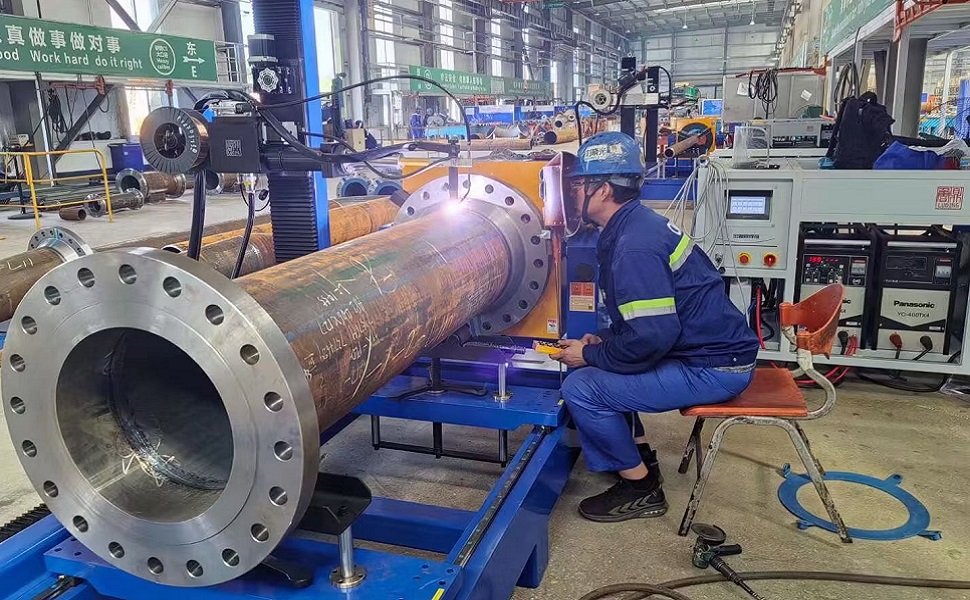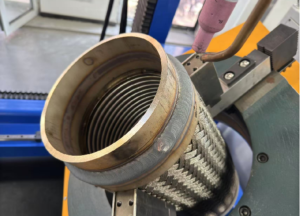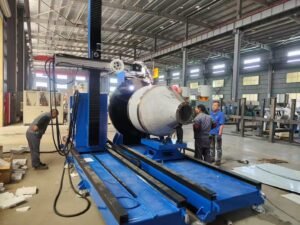In the world of welding, precision and reliability are paramount. Whether you’re working on pipes, metal hoses, expansion joints, or pressure vessels, the need for strong, high-quality welds is crucial for the integrity and safety of the final product. This is where TIG (Tungsten Inert Gas) welding machines, particularly automatic versions, come into play. These machines offer superior control, precision, and efficiency, making them the go-to choice for industries that require clean, durable welds. Importantly, the weld quality achieved through TIG automatic welding is high enough to pass RT (Radiographic Testing), ensuring compliance with strict industry standards.
What is TIG Welding?
TIG welding, also known as Gas Tungsten Arc Welding (GTAW), is a process that uses a non-consumable tungsten electrode to produce the weld. The process relies on an inert gas, typically argon or helium, to shield the weld pool from contamination, ensuring clean and high-quality welds.
TIG welding is renowned for creating fine, precise welds, which is why it’s favored for applications where the weld’s strength and appearance are critical. The control it offers over heat input makes it ideal for thin-walled materials, and its versatility allows for welding a wide range of metals, including stainless steel, aluminum, and titanium.
Why Choose TIG Automatic Welding Machines?
Automated TIG welding machines take the benefits of manual TIG welding to the next level, offering numerous advantages:
Consistent Quality
Automatic TIG machines deliver consistent and repeatable welds, minimizing the variability of manual welding. This ensures that the welds are uniform, durable, and capable of passing RT inspections, which are vital for critical components like pressure vessels.
Increased Efficiency
Automation speeds up the welding process by maintaining a constant arc and travel speed. This improves production throughput without compromising the weld quality, making it easier to meet tight deadlines.
Precision and Control
With advanced control systems, TIG automatic welding machines ensure the precise application of heat and filler material. This precision produces welds with minimal defects, reducing the risk of failure during RT or other non-destructive testing methods.
RT Detectability
Radiographic Testing (RT) is a common non-destructive method used to evaluate the internal integrity of welds. Automatic TIG welds are known for their smooth profiles, minimal porosity, and lack of inclusions, making them highly detectable and reliable under RT.
Cost Savings
Automation reduces the reliance on skilled labor and decreases rework caused by welding defects. This translates to lower overall costs and increased profitability over time.
Applications of TIG Automatic Welding Machines
1. Welding Pipes
In industries like oil and gas, pipes must maintain their structural integrity under extreme conditions. Automatic TIG machines ensure uniform and defect-free welds that can pass RT inspection, guaranteeing leak-proof joints and long-term performance.
2. Metal Hoses
Metal hoses are often used in environments with high pressure or temperature. TIG automatic welding provides clean, precise welds that maintain the flexibility and durability of the hose while ensuring RT compliance for safety-critical applications.
3. Expansion Joints
Expansion joints are subjected to constant movement and thermal stress. Automated TIG welding ensures that the welds have excellent tensile strength and durability, which can be verified through RT, offering confidence in their long-term performance.
4. Pressure Vessels
Pressure vessels require flawless welds due to the high stakes of their application. TIG automatic welding machines produce welds with minimal defects and excellent penetration, ensuring they meet RT standards and provide safe, reliable operation under high pressure.
Key Features of TIG Automatic Welding Machines
When selecting a TIG automatic welding machine, look for the following features to ensure optimal performance:
- Programmable Control: Enables precise adjustments of welding parameters to suit different materials and joint designs.
- RT-Ready Weld Profiles: Machines capable of producing welds with minimal porosity and uniform penetration are better suited for RT inspection.
- Advanced Arc Stability: Ensures a consistent arc for smooth, high-quality welds.
- Inert Gas Flow Control: Protects the weld pool from contamination, ensuring clean welds that meet RT standards.
- Versatility: Adapts to various materials and thicknesses, from thin sheets to heavy plates.
Ensuring RT-Ready Welds with TIG Automatic Welding Machines
Radiographic Testing is a stringent quality assurance measure used to detect internal flaws in welds. Welds produced by TIG automatic welding machines are ideally suited for RT because of their:
- Smooth Weld Beads: Eliminating uneven surfaces that can cause defects during testing.
- Uniform Penetration: Reducing the likelihood of voids and inclusions.
- Low Porosity: Ensuring weld integrity under RT.
By choosing a reliable TIG automatic welding machine, you not only achieve high-quality welds but also ensure that your projects meet the rigorous standards required in industries such as oil and gas, chemical processing, and power generation.
Conclusion
TIG automatic welding machines are transforming the manufacturing landscape by combining precision, efficiency, and consistency. Their ability to produce high-quality, RT-detectable welds makes them indispensable for applications such as pipes, metal hoses, expansion joints, and pressure vessels.
Investing in a TIG automatic welding machine is a step toward ensuring the reliability, safety, and success of your welding operations. Whether you’re focused on improving production speed or meeting strict quality standards, these machines offer a powerful solution tailored to the demands of modern industry.



